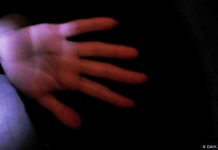
ILOILO City – A 53-year-old man was caught with counterfeit money at the public market of Miag-ao, Iloilo.
Suspect Enrique Lastimoso of Barangay Cochero, Molo, Iloilo City, was detained in Miag-ao Police Station for illegal possession of bank and treasury notes.
Miag-ao police chief Captain Francis Donne Lomahan said the suspect was arrested at 10:30 a.m. on Saturday, July 8, following the complaints of two fish vendors.
Lastimoso bought fish from vendors Ramon Mendoza, Jr., 44, of Barangay Sapa, Miag-ao, and Rolly Nemiada, 49, of Barangay Bolho, Miag-ao, and hurriedly left.
However, the vendors were suspicious of the texture of the P1,000 bill. And when they compared the two bills, they discovered that both had the same serial numbers.
“Gin-compare sang duha ka fish vendors ang P1,000 kay naga tuparay lang sila nakita nila pareho serial numbers amo to gin lagas nila kag nadakpan,” Lomahan told Panay News.
Further recovered from the suspect were eight pieces of counterfeit P1,000 and P500 bill.
“The suspect told us na may ginakuhaan sya na tawo pero indi nya kilala kay gina drop lang. We have to conduct a thorough investigation to know kun sin-o source nya or may grupo sila diri,” Lomahan added.
Last week, there were reports that vendors of fish, dressed chicken, and vegetables at the La Paz public market received fake P1,000 and P500 bills from their customers.
On July 4, a fruit vendor in Jaro Plaza also complained to the police over a fake P500 bill.
Two months ago, a coffee shop in Jaro also fell victim to a fake P1,000 bill.
Iloilo City Police Office director Colonel Joeresty Coronica warned the public.
“Please double-check and be more vigilant against counterfeit or fake bills circulating right now, and report immediately to authorities for appropriate action,” Coronica said.
How to identify fake money using the feel-look-touch method, according to The Beat Asia:
Step 1: Feel
A genuine banknote security paper must feel different from the typical paper and slightly rough. Run your fingers through the paper and feel the embossed prints and tactile marks. The latter is part of the enhanced currency banknotes and is meant to help the elderly and visually impaired distinguish different denominations, but it is also a good indication of a bill’s authenticity.
Step 2: Look
You should also look out for the watermark on the bill. That is placed on the right side and refers to the replica of the face on the note. The watermark should be clearly visible once you hold the currency against the light and should match the face (or faces, in the case of 1,000-peso bills) on the bill.
The next thing to look out for is the BSP-registered serial number. The characters, which typically have six numerical digits and two alphabetical digits, should be ascending in size.
Philippine peso bills consist of security fibers from the abaca and cotton materials used in producing them, making them difficult to replicate. These fibers can be seen through the short lines on both sides of the bill.
Step 3: Tilt
Another way to spot fake money is by holding the bills in your hand and tilting them at different angles. Once the notes are tilted, you should be able to see the vertically arranged security thread that will display the movement of color and designs at different angles. The thread’s shade and size should differ depending on the bill denomination.
An authentic Philippine peso bill should bear a concealed numerical value that matches the currency’s denomination. For 500- and 1,000-peso (cotton-abaca version) bills, you should see a roller bar effect on the currencies’ value panels, an added security feature that the BSP launched in 2020. For the 1,000-peso bank note, the central bank added an optically variable device patch visible on the left side of the currency./PN



